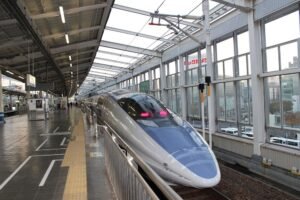How Japan’s Shinkansen bullet trains revolutionized rail travel for generations to come
Sixty years ago, on the early morning of October 1, 1964, Japan witnessed a significant technological milestone that forever changed the way people perceived travel. A sleek, blue-and-white train made its way across Tokyo, gliding effortlessly on elevated tracks toward Osaka. This was no ordinary train. It was the very first Shinkansen, or bullet train, and it would soon become a symbol of Japan’s post-war recovery and its reemergence on the world stage.
The bullet train’s debut was particularly symbolic as it coincided with the 1964 Tokyo Olympic Games. Both the Olympics and the Shinkansen project showcased Japan’s incredible transformation from the devastation of World War II to an economic and technological powerhouse. This period of the 1960s was marked by an era of progress, innovation, and international recognition, as the world took note of Japan’s cutting-edge technology and rapid recovery.

Shinkansen: A New Era in Rail Travel
In the six decades since the launch of that first bullet train, the name “Shinkansen” has become synonymous with speed, efficiency, and modernity. The word itself means “new trunk line,” and the Shinkansen system has grown to be a global standard for high-speed rail travel. Countries around the world look to Japan as a leader in rail technology, with companies like Hitachi and Toshiba exporting billions of dollars’ worth of train technology annually.
The original Tokaido line, which connected Tokyo with Shin-Osaka, was just the beginning. Over time, the network expanded to cover major cities such as Kobe, Kyoto, Hiroshima, and Nagano. Today, trains run at speeds of up to 200 mph (approximately 322 kph), allowing passengers to traverse vast distances across Japan in a fraction of the time it once took.
But the Shinkansen is more than just a fast train. It’s a symbol of Japan’s ability to merge tradition with innovation. It represents the country’s resilience and ambition to push boundaries, both literally and figuratively. Japan’s high-speed rail system helped fuel its ongoing economic development, and the bullet train has been an essential tool in shaping the nation’s modern identity.
Early History of Japan’s Rail System
To fully appreciate the significance of the Shinkansen, it’s essential to look at Japan’s earlier railway history. In the late 19th century, Japan adopted a narrower railway gauge of 3 feet, 6 inches, instead of the more widely used 4 feet, 8.5 inches “standard” gauge seen in North America and Europe. This narrower gauge was more practical for building railways through Japan’s mountainous terrain, but it had limitations. Train speeds were low, and the rail lines lacked the capacity needed for large-scale transportation.
During the early years, traveling between Japan’s major cities was an arduous journey. In 1889, for example, the train ride from Tokyo to Osaka took a staggering 16 and a half hours. Despite being a major improvement over the previous method of walking, which took two to three weeks, this journey was still far from efficient.

The Road to Modernization
As Japan entered the 20th century, there were growing demands for a “standard gauge” rail network that could handle faster trains and heavier loads. The idea of a high-speed rail system had been on the table for decades, but it wasn’t until the 1940s that serious work began on a grand vision. During this period, Japan planned an ambitious “Asian loop line” project. The goal was to connect Japan with Korea and Russia via tunnels under the Pacific Ocean.
However, Japan’s defeat in World War II halted these ambitious plans. The country faced immense challenges in the aftermath of the war, and infrastructure development took a back seat to reconstruction efforts. It wasn’t until the mid-1950s, when Japan’s economy was firmly on the path to recovery, that the high-speed rail project was revived.
By this time, better transportation between Japan’s major cities had become a necessity. The government recognized that fast and efficient travel could play a crucial role in boosting the economy, facilitating business, and fostering national unity. Thus, the Shinkansen project was brought back to life, and in 1964, Japan saw the fruits of its labor with the launch of the Tokaido Shinkansen line.
The Expanding Shinkansen Network
Since its inception, the Shinkansen network has expanded far beyond the original Tokyo to Osaka route. Today, bullet trains operate across the length and breadth of Japan. The country’s four main islands—Honshu, Kyushu, Shikoku, and Hokkaido—are connected by an intricate network of Shinkansen lines that make long-distance travel faster and more convenient than ever before.
In Honshu, the largest of Japan’s islands, the Shinkansen serves the most populous regions, linking cities and driving economic growth. The trains also operate through impressive feats of engineering, such as lengthy sea tunnels that allow the network to reach the southern island of Kyushu and the northernmost island of Hokkaido.
This extensive rail system has not only benefited local commuters and tourists but also helped redistribute economic activity across the country. Cities that were once relatively isolated have become hubs of commerce and industry, thanks to their connection to the Shinkansen network.
The Future of High-Speed Rail
Japan’s Shinkansen continues to evolve. Today’s bullet trains are faster, more efficient, and more environmentally friendly than ever before. Advances in technology have allowed for improvements in safety, with Japan’s bullet trains boasting a near-perfect safety record.
In addition to speed and safety, the Shinkansen has also become a model for sustainable transportation. With growing global concerns about climate change and carbon emissions, the bullet train offers a greener alternative to air travel for domestic and regional routes. The latest models of Shinkansen trains are designed to be energy-efficient, with features that reduce noise and minimize environmental impact.
Japan’s Global Influence in Rail Technology
Japan’s expertise in high-speed rail technology has not gone unnoticed by the rest of the world. Countries around the globe, from the United Kingdom to India, have turned to Japan for guidance and partnership in developing their own high-speed rail networks. Japanese companies like Hitachi and Toshiba are at the forefront of these efforts, exporting both the trains themselves and the expertise required to build and maintain such advanced systems.
The success of the Shinkansen has cemented Japan’s reputation as a global leader in rail technology. As other nations strive to develop their own high-speed rail infrastructure, they look to Japan for inspiration and innovation.
Conclusion: A Lasting Legacy
The Shinkansen is much more than a high-speed train. It is a symbol of Japan’s resilience, ambition, and technological prowess. From its humble beginnings as a post-war recovery project to its status as a global standard in rail travel, the Shinkansen has left an indelible mark on both Japan and the world.
As we reflect on the 60-year journey of the Shinkansen, it is clear that this revolutionary mode of transport has not only changed the way people travel but also shaped the modern identity of Japan. With continued advancements in rail technology, the future of high-speed travel looks as bright as ever.
Related
Discover more from NewsPour
Subscribe to get the latest posts to your email.




Let your voice be heard! Share your thoughts and ignite discussions.